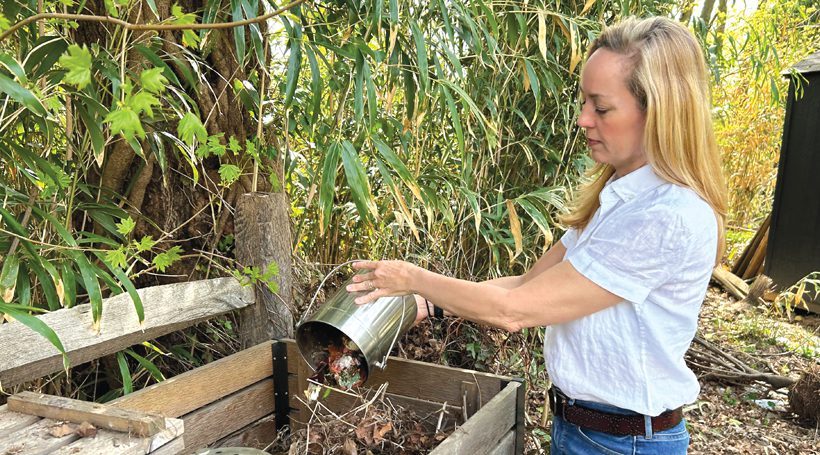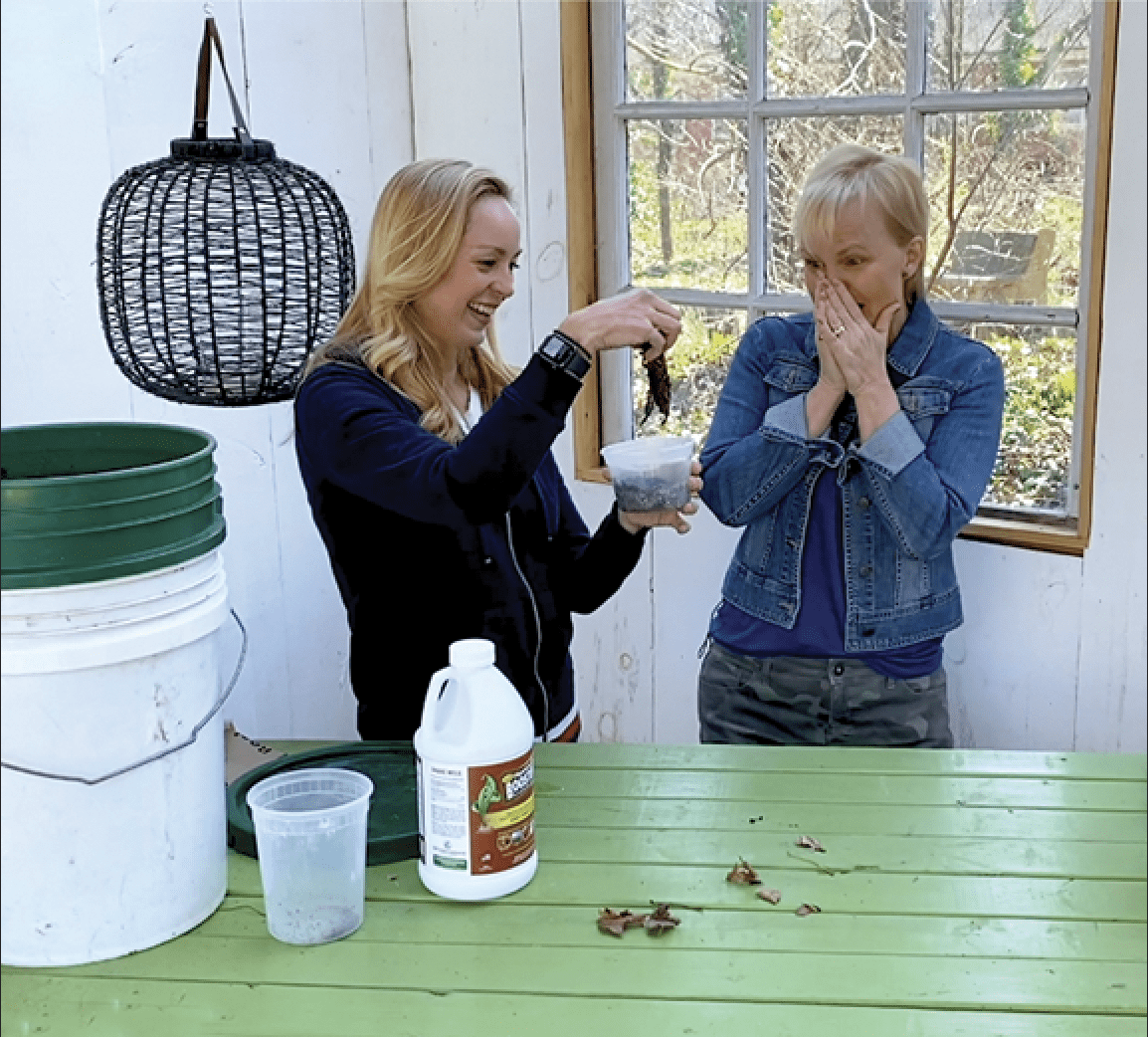Toni Farmer isn’t afraid to get her hands dirty. You can see for yourself as she helps SJ Mag’s Marianne Aleardi learn more about gardening in each episode of our Facebook series, “The Goal is to Become a Gardener.”
After 3 seasons, Toni finally convinced Marianne to try her hand at composting (which Marianne says is off to a very slow start). We asked Toni to share some tips for starting a compost pile – and clue us all in on what exactly a worm farm is.
Q: Why is it a good idea to start composting?
Composting is one of the best things you can do to help your garden. It’s all about keeping your soil healthy, which is the foundation of our gardens. By adding an inch or 2 of compost to your beds each season, you’re adding organic matter and nutrients, and improving the soil structure. That helps keep your fruits, vegetables and flowers growing strong. But today, composting isn’t just about getting healthy soil.
Q: What’s it about, then?
Our food waste systems have become extremely harmful to the environment. When your food goes into the trash, it’s sent to a landfill where it breaks down over time with the rest of our trash and produces methane, a greenhouse gas that’s responsible for around 30 percent of global warming since pre-industrial times. When we put our food waste in our own compost pile, which gets aired out each year, we’re cutting down the amount of methane we add to the atmosphere.
Q: So how do we start?
 Before you start, know that this is a long process at first. If you start tomorrow, you won’t have usable compost for 2 years. But trust me, it will go by in the blink of an eye. I currently have 3 different piles, one has been working for 2 years and I use it in my garden, the second was started last year, and now I turn that and it’s breaking down, and the third I just started this year and will be adding my food scraps to.
Before you start, know that this is a long process at first. If you start tomorrow, you won’t have usable compost for 2 years. But trust me, it will go by in the blink of an eye. I currently have 3 different piles, one has been working for 2 years and I use it in my garden, the second was started last year, and now I turn that and it’s breaking down, and the third I just started this year and will be adding my food scraps to.
The first step is to choose a place in your yard – and a structure – to store your pile. There are plenty of DIY options. My favorite is using 3 palettes to make a ‘U’ shape and put the pile in the middle. Or you can purchase a covered bin, some even come with a crank on the side to make turning it easier.
Q: We have to turn our compost?
Once a year, you’ll want to get a rake or shovel and spend some time flipping your compost so it all airs out. Air makes every-thing better.
Q: Ok, once we have our structure, do we just throw food in it?
Not exactly. You’re going to be adding what we call greens and browns to make your pile. Browns are dried, dead things that you’ll find in your backyard, like leaves and sticks. Greens are anything that was recently living, like food scraps and grass clippings. The ideal ratio we’re aiming for is 2/3 browns to 1/3 greens. I’ve got a good trick to know if your ratio is working: If your compost is smelling or attracting bugs, that means you have too many greens, and if it’s not breaking down, that means you have too many browns.
Q: Do you go out to your compost pile every day to dump your food scraps?
No, I have a little compost bin that I keep in my kitchen. It has a charcoal filter under the lid that keeps it from smelling, and when I’m cooking, I’ll throw my scraps in there and then just take it out to the pile once a week, then cover the food with about 6 inches of leaves. You’ll do that for a year, then wait a year for it to break down and become compost while you start a new pile.
Q: Is there any food that shouldn’t go in the pile?
It’s not a long list, but there are some foods you’ll want to keep out of your pile. A big one is meat, because it will usually end up smelling and will attract animals. Attracting animals won’t necessarily hurt your compost pile, but if they find your backyard, it’s likely they’ll start to eat from your garden – and we don’t want that.
Another category to stay away from is processed foods. Many processed foods have small amounts of pesticides in them which won’t hurt us but could harm the worms that are working to break down the matter in your compost pile. You also can’t add many tropical fruits, like pineapple, kiwi and papaya, because they have an enzyme that will kill worms.
Q: Do we need to get comfortable seeing worms?
 Worms do so much for us when it comes to our soil. I’m so grateful for them, and you should be too! Sure they’re a little creepy crawly, but worms are going to put in the work to help your compost pile transform from sticks, leaves and food to healthy, nutrient-packed soil. In fact, if you want to speed up your composting process, you can even start a worm farm.
Worms do so much for us when it comes to our soil. I’m so grateful for them, and you should be too! Sure they’re a little creepy crawly, but worms are going to put in the work to help your compost pile transform from sticks, leaves and food to healthy, nutrient-packed soil. In fact, if you want to speed up your composting process, you can even start a worm farm.
Q: What’s a worm farm?
A worm farm is a composting method that uses the same composting strategies as a backyard pile (2/3 browns and 1/3 greens), but you add a ton of worms. I like to use red wigglers, between 50 to 100 of them. They’re excellent for breaking down the compost quickly, but they can’t survive cold temperatures, so you’ll have to keep your worm farm inside during the winter.
I keep mine under my sink in 2 buckets. I fill the first with soil from my backyard, leaves, some cardboard, a banana, a little water and worms, and it has small holes drilled in the top and bottom so the worms can breathe. I place that bucket in the second bucket to catch any dirt, water or worms that might fall through the holes. Then, instead of pouring all of my food scraps onto my backyard compost pile, I’ll pour some into my worm farm.
Once the compost is fully broken down, and you have your beautiful soil, you can either pick out the worms individually or you can add something sweet, like a banana or sweet potato, the day before and the worms will flock to it. Then you can easily scoop them out and start a new farm.
Q: And we won’t have to wait 2 years for compost?
These worms will break down your compost in a matter of a few months, sometimes even weeks. The worms will eat everything that’s in the bucket and turn it into beautiful, nutrient-rich soil. And my favorite part is making worm tea. Don’t worry, it’s not something you drink. You make it by soaking your worm farm and letting the water drain out the bottom. The water will be a dark color because it’s collected all the nutrients from your compost. Put the water in a watering can and use it on your garden to give it a boost of nutrients.
 The Goal is to Become A Gardener
The Goal is to Become A Gardener
Marianne & Toni build a worm farm
It wasn’t easy, but Toni showed Marianne how to build a worm farm on “The Goal is to Become a Gardener” (season 4, ep 3), and while Marianne was a little overwhelmed by the worms, the two share lots of details on how you can also get started composting. There’s so much to learn on this season – how to build a DIY fountain in your backyard, getting started planting your garden and how South Jersey wineries take backyard gardening to a whole other level.
See the latest episodes – and all shows from past seasons – at SJ Magazine’s Facebook page.



 The Goal is to Become A Gardener
The Goal is to Become A Gardener










